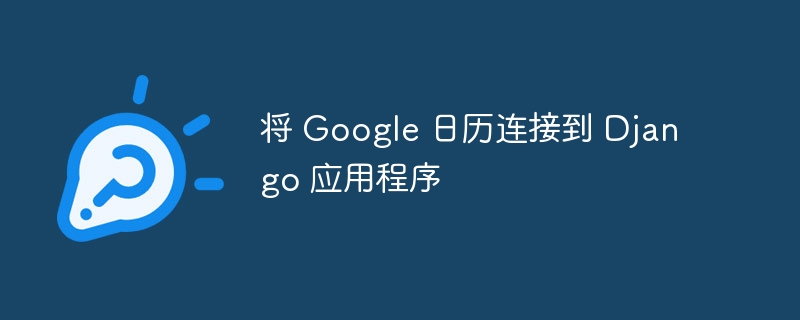将 Google 日历连接到 Django 应用程序
来源:dev.to
时间:2024-11-29 13:00:47 112浏览 收藏
来到golang学习网的大家,相信都是编程学习爱好者,希望在这里学习文章相关编程知识。下面本篇文章就来带大家聊聊《将 Google 日历连接到 Django 应用程序》,介绍一下,希望对大家的知识积累有所帮助,助力实战开发!

将 google 日历与 django 应用程序无缝集成以增强日程安排和事件管理的分步指南。
将 google 日历与 django 应用程序集成可以通过启用日程安排、事件管理和日历同步来显着增强 web 应用程序的功能。本指南将引导您完成将 google 日历连接到 django 应用程序的步骤,涵盖从设置 google api 凭据到在 django 中实现必要代码的所有内容。
先决条件
开始之前,请确保您具备以下条件:
1. django 应用程序: 一个工作的 django 应用程序。
2. google api 控制台帐户: 访问 google cloud console。
3.已启用 google calendar api: 应在 google cloud console 中为您的项目启用 google calendar api。
第 1 步:设置 google cloud 项目
1.创建项目:
转到 google cloud console 并创建一个新项目。
2.启用 google 日历 api:
导航至“api & services” > “library” 并搜索“google calendar api”。为您的项目启用它。
3.配置同意屏幕:
- 导航至“api & services” > “oauth 同意屏幕”并配置同意屏幕。
- 现在选择您想要的 oauth 类型(在本例中为外部,因为拥有 google 帐户的任何人都可以访问该应用程序)。
- 根据需要设置同意屏幕的所有数据,如应用程序名称、徽标、支持电子邮件等。
- 点击“添加或删除范围”并添加以下范围,…/auth/userinfo.email、…/auth/userinfo.profile、openid 来访问用户信息以及所有 google calendar api 范围来访问用户的 google 日历。然后点击更新保存。
- 下一步添加测试用户。由于我们的应用程序尚未经过谷歌验证,因此只有此列表中的用户才能注册到此谷歌项目。因此,请添加您将用于测试 google 日历集成的所有测试电子邮件。 完成后继续创建凭据。
4.创建 oauth 凭据:
转到“api & services” > “credentials” 并创建凭据。选择 oauth 客户端 id 作为凭据类型。将web应用程序设置为应用程序类型并填写应用程序详细信息。
- 授权重定向 uri:添加 django 应用程序的重定向 url(例如,用于本地开发的 http://localhost:8000/oauth2callback)。
5.下载 json 凭证:
下载 oauth 2.0 凭据 json 文件并妥善保管。该文件包含您的 client_id、client_secret 和其他重要信息。
第2步:安装所需的python包
您需要一些 python 包来与 google api 交互:
pip install google-auth google-auth-oauthlib google-auth-httplib2 google-api-python-client
第 3 步:配置 django 设置
使用以下内容更新您的 settings.py:
import os # google calendar api google_client_secrets_file = os.path.join(base_dir, 'path/to/client_secret.json') google_api_scopes = ['https://www.googleapis.com/auth/calendar'] redirect_uri = 'http://localhost:8000/oauth2callback' # or your production url
第 4 步:创建 oauth2 流程
创建一个视图来处理 oauth2 流程:
from google.oauth2.credentials import credentials
from google_auth_oauthlib.flow import flow
from django.shortcuts import redirect
from django.http import httpresponse
from django.conf import settings
def google_calendar_init(request):
flow = flow.from_client_secrets_file(
settings.google_client_secrets_file,
scopes=settings.google_api_scopes,
redirect_uri=settings.redirect_uri
)
authorization_url, state = flow.authorization_url(
access_type='offline',
include_granted_scopes='true'
)
request.session['state'] = state
return redirect(authorization_url)
def google_calendar_redirect(request):
state = request.session['state']
flow = flow.from_client_secrets_file(
settings.google_client_secrets_file,
scopes=settings.google_api_scopes,
state=state,
redirect_uri=settings.redirect_uri
)
flow.fetch_token(authorization_response=request.build_absolute_uri())
credentials = flow.credentials
request.session['credentials'] = credentials_to_dict(credentials)
return httpresponse('calendar integration complete. you can now use google calendar with your django app.')
def credentials_to_dict(credentials):
return {'token': credentials.token,
'refresh_token': credentials.refresh_token,
'token_uri': credentials.token_uri,
'client_id': credentials.client_id,
'client_secret': credentials.client_secret,
'scopes': credentials.scopes}
第 5 步:处理 google 日历 api 请求
oauth2 流程完成后,您可以向 google calendar api 发出经过身份验证的请求。这是一个列出用户日历事件的简单示例:
from googleapiclient.discovery import build
def list_events(request):
credentials = credentials(**request.session['credentials'])
service = build('calendar', 'v3', credentials=credentials)
events_result = service.events().list(calendarid='primary', maxresults=10).execute()
events = events_result.get('items', [])
return httpresponse(events)
第 6 步:更新 url
在 urls.py 中添加视图的 url:
from django.urls import path
from . import views
urlpatterns = [
path('google-calendar/init/', views.google_calendar_init, name='google_calendar_init'),
path('oauth2callback/', views.google_calendar_redirect, name='google_calendar_redirect'),
path('google-calendar/events/', views.list_events, name='list_events'),
]
第 7 步:运行和测试
启动你的 django 服务器:
使用 python manage.py runserver 运行 django 开发服务器。验证:
在浏览器中导航至 /google-calendar/init/。您将被重定向到 google 的 oauth2 同意页面。访问活动:
身份验证后,前往 /google-calendar/events/ 查看您的 google 日历活动。
结论
将 google 日历与 django 应用程序集成,让您可以直接在应用程序中构建强大的日程安排功能。通过遵循本指南,您已经设置了 oauth2 身份验证、连接到 google calendar api 并获取了日历事件。您现在可以根据需要扩展此集成以包括事件创建、更新和其他日历管理功能。
ps:请记住安全地处理凭据并确保正确的错误处理以实现强大的应用程序。
理论要掌握,实操不能落!以上关于《将 Google 日历连接到 Django 应用程序》的详细介绍,大家都掌握了吧!如果想要继续提升自己的能力,那么就来关注golang学习网公众号吧!
-
501 收藏
-
501 收藏
-
501 收藏
-
501 收藏
-
501 收藏
-
300 收藏
-
212 收藏
-
160 收藏
-
321 收藏
-
133 收藏
-
399 收藏
-
280 收藏
-
349 收藏
-
143 收藏
-
287 收藏
-
377 收藏
-
274 收藏
-

- 前端进阶之JavaScript设计模式
- 设计模式是开发人员在软件开发过程中面临一般问题时的解决方案,代表了最佳的实践。本课程的主打内容包括JS常见设计模式以及具体应用场景,打造一站式知识长龙服务,适合有JS基础的同学学习。
- 立即学习 543次学习
-

- GO语言核心编程课程
- 本课程采用真实案例,全面具体可落地,从理论到实践,一步一步将GO核心编程技术、编程思想、底层实现融会贯通,使学习者贴近时代脉搏,做IT互联网时代的弄潮儿。
- 立即学习 516次学习
-

- 简单聊聊mysql8与网络通信
- 如有问题加微信:Le-studyg;在课程中,我们将首先介绍MySQL8的新特性,包括性能优化、安全增强、新数据类型等,帮助学生快速熟悉MySQL8的最新功能。接着,我们将深入解析MySQL的网络通信机制,包括协议、连接管理、数据传输等,让
- 立即学习 500次学习
-

- JavaScript正则表达式基础与实战
- 在任何一门编程语言中,正则表达式,都是一项重要的知识,它提供了高效的字符串匹配与捕获机制,可以极大的简化程序设计。
- 立即学习 487次学习
-

- 从零制作响应式网站—Grid布局
- 本系列教程将展示从零制作一个假想的网络科技公司官网,分为导航,轮播,关于我们,成功案例,服务流程,团队介绍,数据部分,公司动态,底部信息等内容区块。网站整体采用CSSGrid布局,支持响应式,有流畅过渡和展现动画。
- 立即学习 485次学习
